check engine RENAULT CLIO 2012 X85 / 3.G Repair Manual
[x] Cancel search | Manufacturer: RENAULT, Model Year: 2012, Model line: CLIO, Model: RENAULT CLIO 2012 X85 / 3.GPages: 268, PDF Size: 8.73 MB
Page 205 of 268
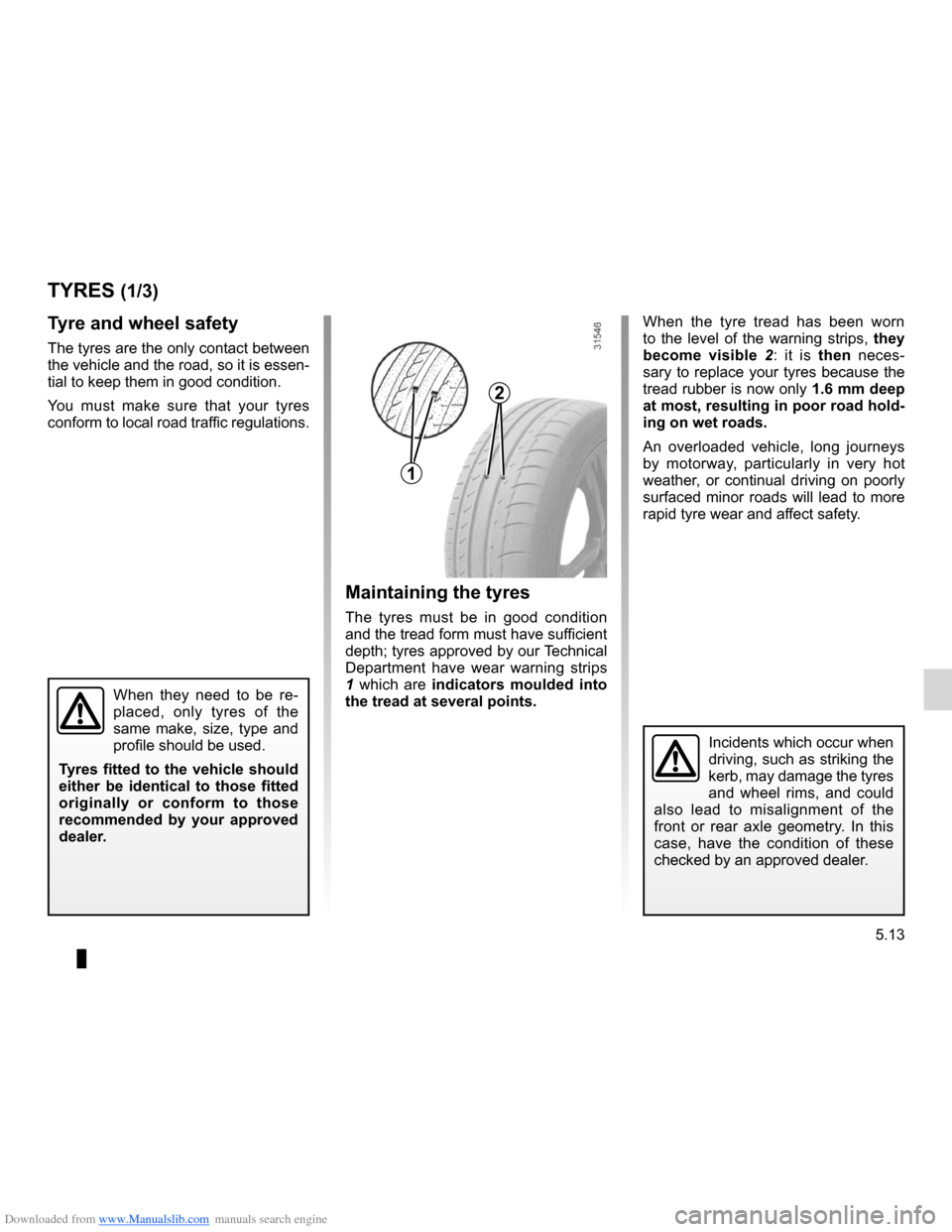
Downloaded from www.Manualslib.com manuals search engine tyres ...................................................... (up to the end of the DU)
wheels (safety) ..................................... (up to the end of the DU)
5.13
ENG_UD22328_2
Pneumatiques (X85 - B85 - C85 - S85 - K85 - Renault)
ENG_NU_853-7_BCSK85_Renault_5
Tyre and wheel safety
The tyres are the only contact between
the vehicle and the road, so it is essen-
tial to keep them in good condition.
You must make sure that your tyres
conform to local road traffic regulations. When the tyre tread has been worn
to the level of the warning strips, they
become visible
2: it is then neces -
sary to replace your tyres because the
tread rubber is now only 1.6 mm deep
at most, resulting in poor road hold -
ing on wet roads.
An overloaded vehicle, long journeys
by motorway, particularly in very hot
weather, or continual driving on poorly
surfaced minor roads will lead to more
rapid tyre wear and affect safety.
Tyres (tyre and wheel safety, use in winter)
Maintaining the tyres
The tyres must be in good condition
and the tread form must have sufficient
depth; tyres approved by our Technical
Department have wear warning strips
1 which are indicators moulded into
the tread at several points.
TYRES (1/3)
When they need to be re -
placed, only tyres of the
same make, size, type and
profile should be used.
Tyres fitted to the vehicle should
either be identical to those fitted
originally or conform to those
recommended by your approved
dealer.
Incidents which occur when
driving, such as striking the
kerb, may damage the tyres
and wheel rims, and could
also lead to misalignment of the
front or rear axle geometry. In this
case, have the condition of these
checked by an approved dealer.
1
2
Page 206 of 268
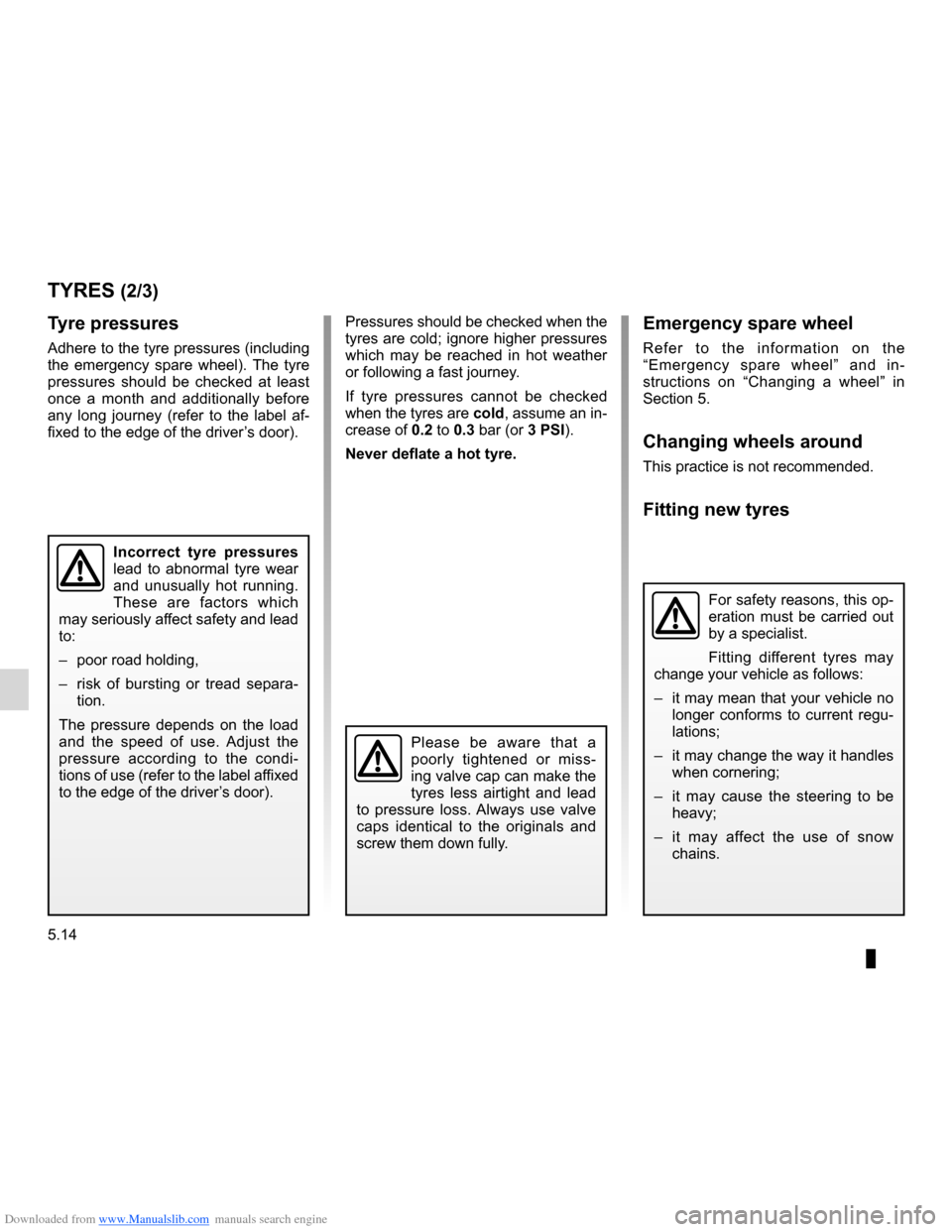
Downloaded from www.Manualslib.com manuals search engine tyre pressure.......................................................... (current page)
5.14
ENG_UD22328_2
Pneumatiques (X85 - B85 - C85 - S85 - K85 - Renault)
ENG_NU_853-7_BCSK85_Renault_5
Jaune NoirNoir texte
Emergency spare wheel
Refer to the information on the
“Emergency spare wheel” and in -
structions on “Changing a wheel” in
Section 5.
Changing wheels around
This practice is not recommended.
Fitting new tyres
For safety reasons, this op-
eration must be carried out
by a specialist.
Fitting different tyres may
change your vehicle as follows:
– it may mean that your vehicle no
longer conforms to current regu-
lations;
– it may change the way it handles
when cornering;
– it may cause the steering to be
heavy;
– it may affect the use of snow
chains.
Pressures should be checked when the
tyres are cold; ignore higher pressures
which may be reached in hot weather
or following a fast journey.
If tyre pressures cannot be checked
when the tyres are cold, assume an in-
crease of 0.2 to 0.3 bar (or 3 PSI).
Never deflate a hot tyre.
TYRES (2/3)
Please be aware that a
poorly tightened or miss -
ing valve cap can make the
tyres less airtight and lead
to pressure loss. Always use valve
caps identical to the originals and
screw them down fully.
Incorrect tyre pressures
lead to abnormal tyre wear
and unusually hot running.
These are factors which
may seriously affect safety and lead
to:
– poor road holding,
– risk of bursting or tread separa -
tion.
The pressure depends on the load
and the speed of use. Adjust the
pressure according to the condi -
tions of use (refer to the label affixed
to the edge of the driver’s door).
Tyre pressures
Adhere to the tyre pressures (including
the emergency spare wheel). The tyre
pressures should be checked at least
once a month and additionally before
any long journey (refer to the label af -
fixed to the edge of the driver’s door).
Page 210 of 268

Downloaded from www.Manualslib.com manuals search engine 5.18
ENG_UD14672_3
Projecteurs avant avec lampes halogènes : remplacement des lampes (X\
85 - B85 - C85 - S85 - K85 - Renault)
ENG_NU_853-7_BCSK85_Renault_5
Additional cornering light
Due to their reduced accessibility
(sometimes requiring the removal of
bodywork or mechanical components),
we advise you to have your bulbs 7 re-
placed by an approved Dealer.
Bulb type: H7.
Front side light
Remove cover E, then pull bulb holder 6
to access the bulb.
Bulb type: W5W.
Direction indicator lights
Turn bulb holder F a quarter of a turn
and take out the bulb.
Bulb type: orange PY21 W.
Once the bulb has been replaced,
check that it is properly secured.
The bulbs are under pres -
sure and can break when
replaced.
Risk of injury.
HALOGEN HEADLIGHTS: changing bulbs (3/3)
The engine may be hot
when carrying out opera-
tions in close proximity. In
addition, the engine cooling
fan can come on at any moment.
Risk of injury.
To comply with local legislation, or
as a precaution, you can obtain an
emergency kit containing a set of
spare bulbs and fuses from an ap -
proved dealer.
E
6
F
7
Page 218 of 268

Downloaded from www.Manualslib.com manuals search engine fuses ..................................................... (up to the end of the DU)
5.26
ENG_UD24921_5
Fusibles (X85 - B85 - C85 - S85 - K85 - Renault)
ENG_NU_853-7_BCSK85_Renault_5
Jaune NoirNoir texte
Remove the fuse using tweezers 2, lo-
cated on the cover.
To remove the fuse from the tweezers,
slide the fuse to the side.
It is not advisable to use the free fuse
locations.
Fuses
Check the fuse in question
and replace it, if neces-
sary, by a fuse of the same
rating.
If a fuse is fitted with too high a
rating, it may cause the electrical
circuit to overheat (risk of fire) in the
event of an item of equipment using
an excessive amount of current.
Fuse box 1
If any electrical component does not
work, check the condition of the fuses.
Depending on the vehicle, open the
cover to the right of the steering wheel
or the glove box.
To identify the fuses, refer to the fuse
allocation sticker (shown on the follow -
ing page).
FUSES (1/2)
1
In accordance with local legislation
or as a precautionary measure:
obtain an emergency kit containing
a set of spare bulbs and fuses from
an approved Dealer.
2
Page 220 of 268

Downloaded from www.Manualslib.com manuals search engine 5.28
ENG_UD12592_2
Batterie : dépannage (X85 - B85 - C85 - S85 - K85 - Renault)
ENG_NU_853-7_BCSK85_Renault_5
Jaune NoirNoir texte
To avoid all risk of sparks:
– ensure that any consumers are
switched off before disconnecting or
reconnecting the battery;
– when charging, stop the charger
before connecting or disconnecting
the battery;
– to avoid creating a short circuit be -
tween the terminals, do not place
metal objects on the battery;
– always wait at least one minute after
the engine has been switched off
before disconnecting a battery;
– make sure that you reconnect the
battery terminals after refitting.
Battery
Refitting the battery covers
– position cover C in its hinges and clip
it in place;
– then position cover B in its hinges
and clip it in place;
Check that the two covers B and C are
correctly locked.
Depending on the vehicle, reposition
block A, clipping first the rear, then the
front. Ensure it is correctly locked in
place.
Access to the battery
Depending on the vehicle, press tab 1
and tilt block A backwards to unclip it.
Unclip cover B and remove it, then
unclip cover C and remove it.
BATTERY: troubleshooting (1/4)
AB
C
1
The engine may be hot
during operations in close
proximity. In addition, the
engine cooling fan may
start at any moment.
Risk of injury.
Page 221 of 268
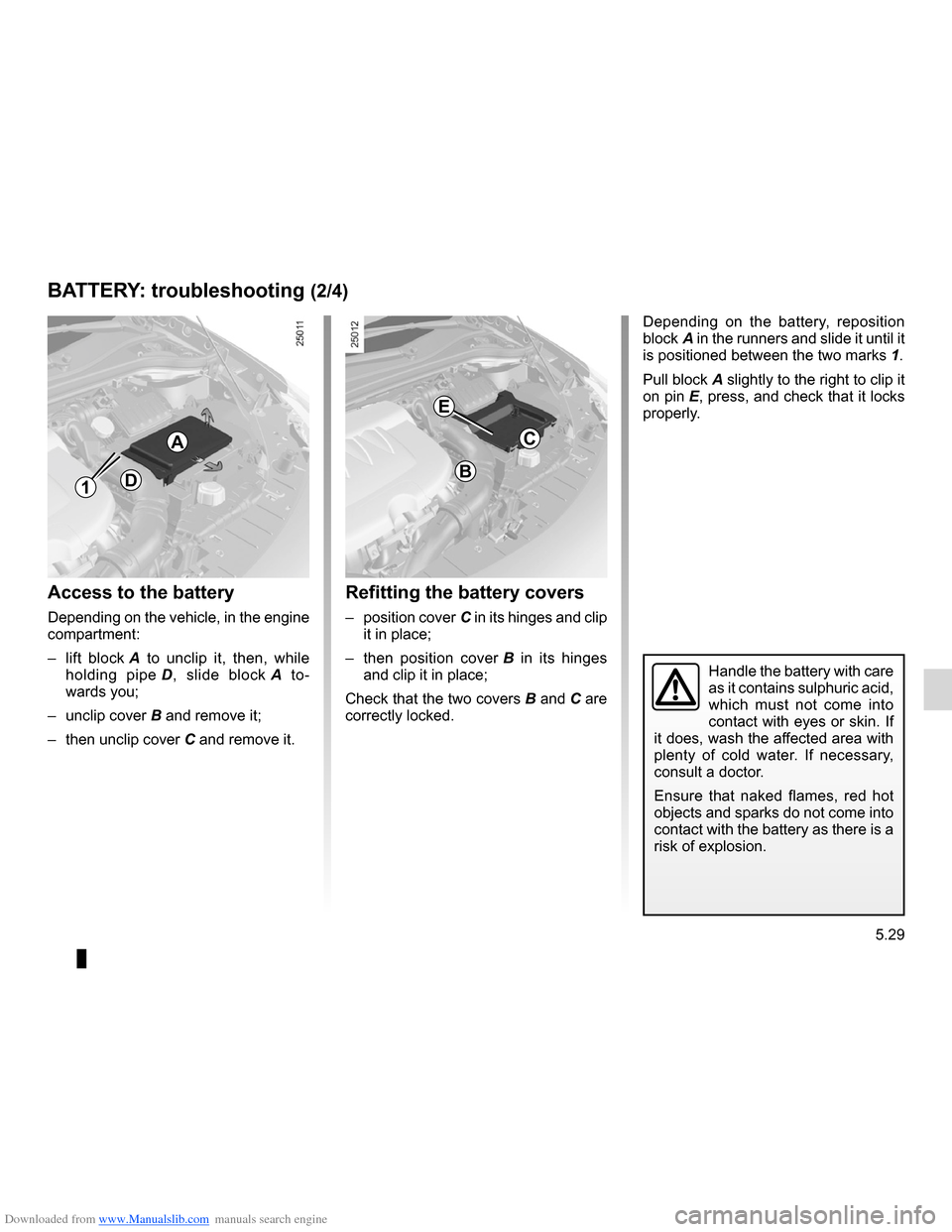
Downloaded from www.Manualslib.com manuals search engine JauneNoirNoir texte
5.29
ENG_UD12592_2
Batterie : dépannage (X85 - B85 - C85 - S85 - K85 - Renault)
ENG_NU_853-7_BCSK85_Renault_5
Depending on the battery, reposition
block A in the runners and slide it until it
is positioned between the two marks 1.
Pull block A slightly to the right to clip it
on pin E, press, and check that it locks
properly.
Refitting the battery covers
– position cover C in its hinges and clip
it in place;
– then position cover B in its hinges
and clip it in place;
Check that the two covers B and C are
correctly locked.
Access to the battery
Depending on the vehicle, in the engine
compartment:
– lift block A to unclip it, then, while
holding pipe D , slide block A to -
wards you;
– unclip cover B and remove it;
– then unclip cover C and remove it.
BATTERY: troubleshooting (2/4)
D
A
B
C
E
1
Handle the battery with care
as it contains sulphuric acid,
which must not come into
contact with eyes or skin. If
it does, wash the affected area with
plenty of cold water. If necessary,
consult a doctor.
Ensure that naked flames, red hot
objects and sparks do not come into
contact with the battery as there is a
risk of explosion.
Page 222 of 268
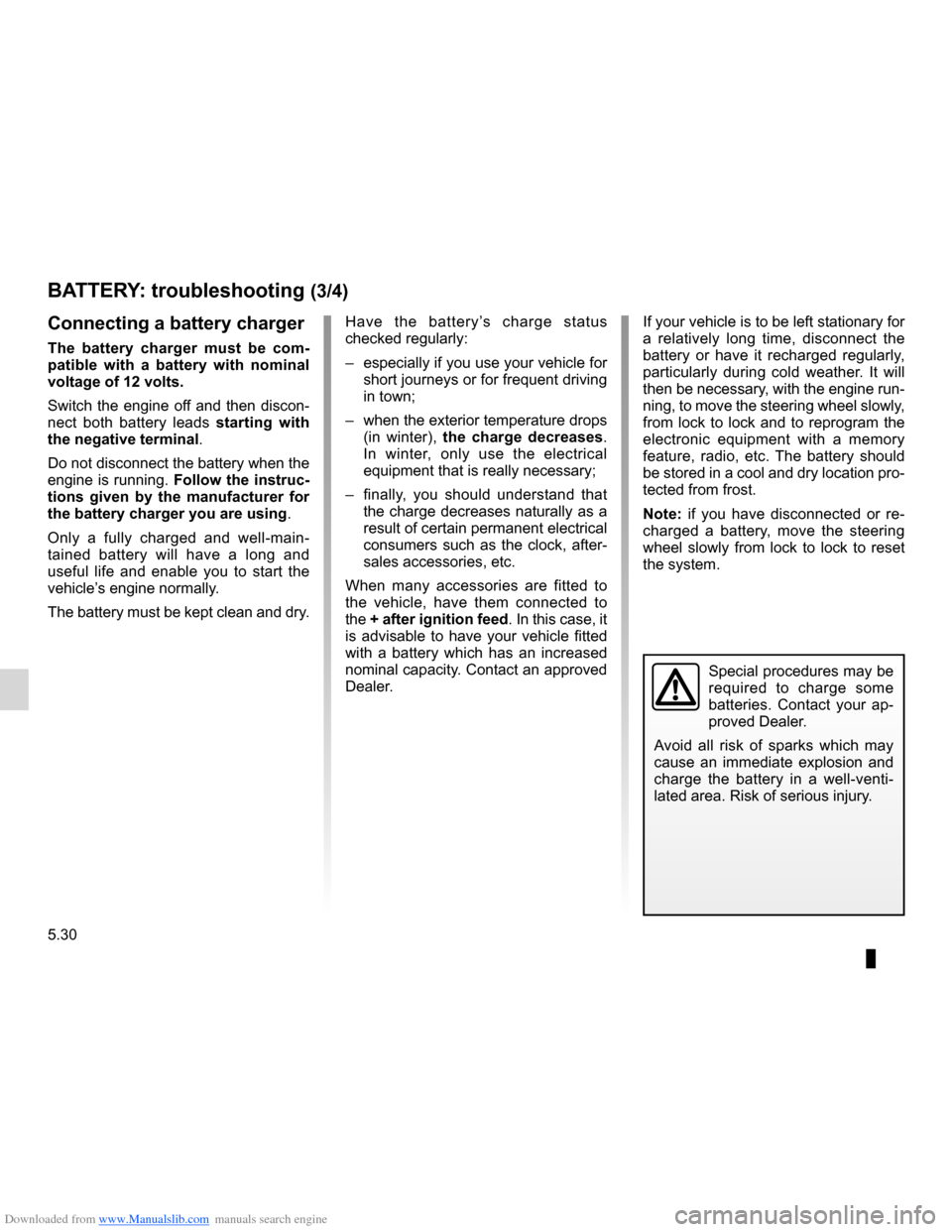
Downloaded from www.Manualslib.com manuals search engine 5.30
ENG_UD12592_2
Batterie : dépannage (X85 - B85 - C85 - S85 - K85 - Renault)
ENG_NU_853-7_BCSK85_Renault_5
Jaune NoirNoir texte
BATTERY: troubleshooting (3/4)
Special procedures may be
required to charge some
batteries. Contact your ap-
proved Dealer.
Avoid all risk of sparks which may
cause an immediate explosion and
charge the battery in a well-venti -
lated area. Risk of serious injury.
If your vehicle is to be left stationary for
a relatively long time, disconnect the
battery or have it recharged regularly,
particularly during cold weather. It will
then be necessary, with the engine run-
ning, to move the steering wheel slowly,
from lock to lock and to reprogram the
electronic equipment with a memory
feature, radio, etc. The battery should
be stored in a cool and dry location pro-
tected from frost.
Note: if you have disconnected or re -
charged a battery, move the steering
wheel slowly from lock to lock to reset
the system.
Have the battery’s charge status
checked regularly:
–
especially if you use your vehicle for
short journeys or for frequent driving
in town;
– when the exterior temperature drops
(in winter), the charge decreases .
In winter, only use the electrical
equipment that is really necessary;
– finally, you should understand that
the charge decreases naturally as a
result of certain permanent electrical
consumers such as the clock, after-
sales accessories, etc.
When many accessories are fitted to
the vehicle, have them connected to
the + after ignition feed. In this case, it
is advisable to have your vehicle fitted
with a battery which has an increased
nominal capacity. Contact an approved
Dealer.Connecting a battery charger
The battery charger must be com -
patible with a battery with nominal
voltage of 12 volts.
Switch the engine off and then discon -
nect both battery leads starting with
the negative terminal.
Do not disconnect the battery when the
engine is running. Follow the instruc-
tions given by the manufacturer for
the battery charger you are using.
Only a fully charged and well-main -
tained battery will have a long and
useful life and enable you to start the
vehicle’s engine normally.
The battery must be kept clean and dry.
Page 223 of 268

Downloaded from www.Manualslib.com manuals search engine JauneNoirNoir texte
5.31
ENG_UD12592_2
Batterie : dépannage (X85 - B85 - C85 - S85 - K85 - Renault)
ENG_NU_853-7_BCSK85_Renault_5
Start the engine as you would normally.
As soon as it is running, disconnect
leads A and B in the reverse order (5-
4-3-2).Attach the positive lead A on support 1
to terminal 2 (+) of the discharged bat-
tery, then to terminal 3 (+) of the bat -
tery supplying the current.
Attach negative lead B to terminal 4
(–) of the battery supplying the current,
then to terminal 5 (–) of the discharged
battery.
Starting the vehicle using the
battery from another vehicle
Proceed as follows when starting your
vehicle from another vehicle’s battery:
Obtain suitable jump leads (large) from
an approved Dealer or, if you already
have jump leads, ensure that they are
in perfect condition.
The two batteries must have an iden-
tical nominal voltage of 12 volts. The
battery supplying the current should
have a capacity (amp-hours, Ah) which
is at least the same as that of the dis-
charged battery.
Ensure that there is no risk of contact
between the two vehicles (risk of short
circuiting when the positive terminals
are connected) and that the discharged
battery is properly connected. Switch
off your vehicle ignition.
Start the engine of the vehicle supply -
ing the current and run it at an interme-
diate engine speed.
BATTERY: troubleshooting (4/4)
A
4
B
3
25
1
1
Leads A and B must only be con -
nected to the terminals indicated.
Check that there is no con-
tact between leads A and B
and that the positive lead A
is not touching any metal
parts on the vehicle supplying the
current.
Risk of injury and/or damage to the
vehicle.
Page 224 of 268
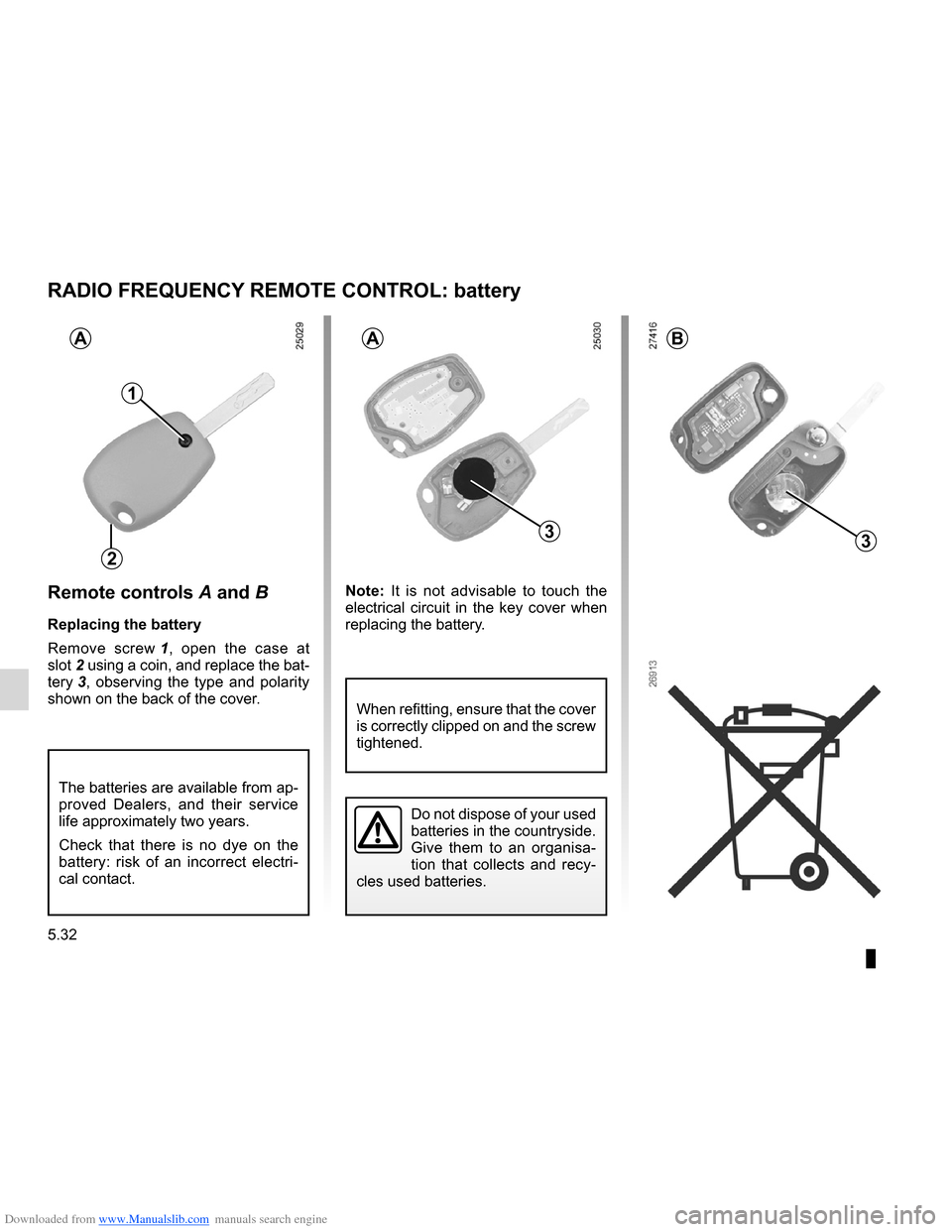
Downloaded from www.Manualslib.com manuals search engine battery (remote control) ........................ (up to the end of the DU)
5.32
ENG_UD12595_2
Télécommandes à radiofréquence : piles (X85 - B85 - C85 - S\
85 - K85 - Renault)
ENG_NU_853-7_BCSK85_Renault_5
Remote controls A and B
Replacing the battery
Remove screw 1 , open the case at
slot 2 using a coin, and replace the bat-
tery 3 , observing the type and polarity
shown on the back of the cover. Note:
It is not advisable to touch the
electrical circuit in the key cover when
replacing the battery.
Radio frequency remote control: battery
The batteries are available from ap-
proved Dealers, and their service
life approximately two years.
Check that there is no dye on the
battery: risk of an incorrect electri -
cal contact.
RADIO FREQUENCY REMOTE CONTROL: battery
2
1
3
AAB
3
Do not dispose of your used
batteries in the countryside.
Give them to an organisa-
tion that collects and recy -
cles used batteries.
When refitting, ensure that the cover
is correctly clipped on and the screw
tightened.
Page 225 of 268
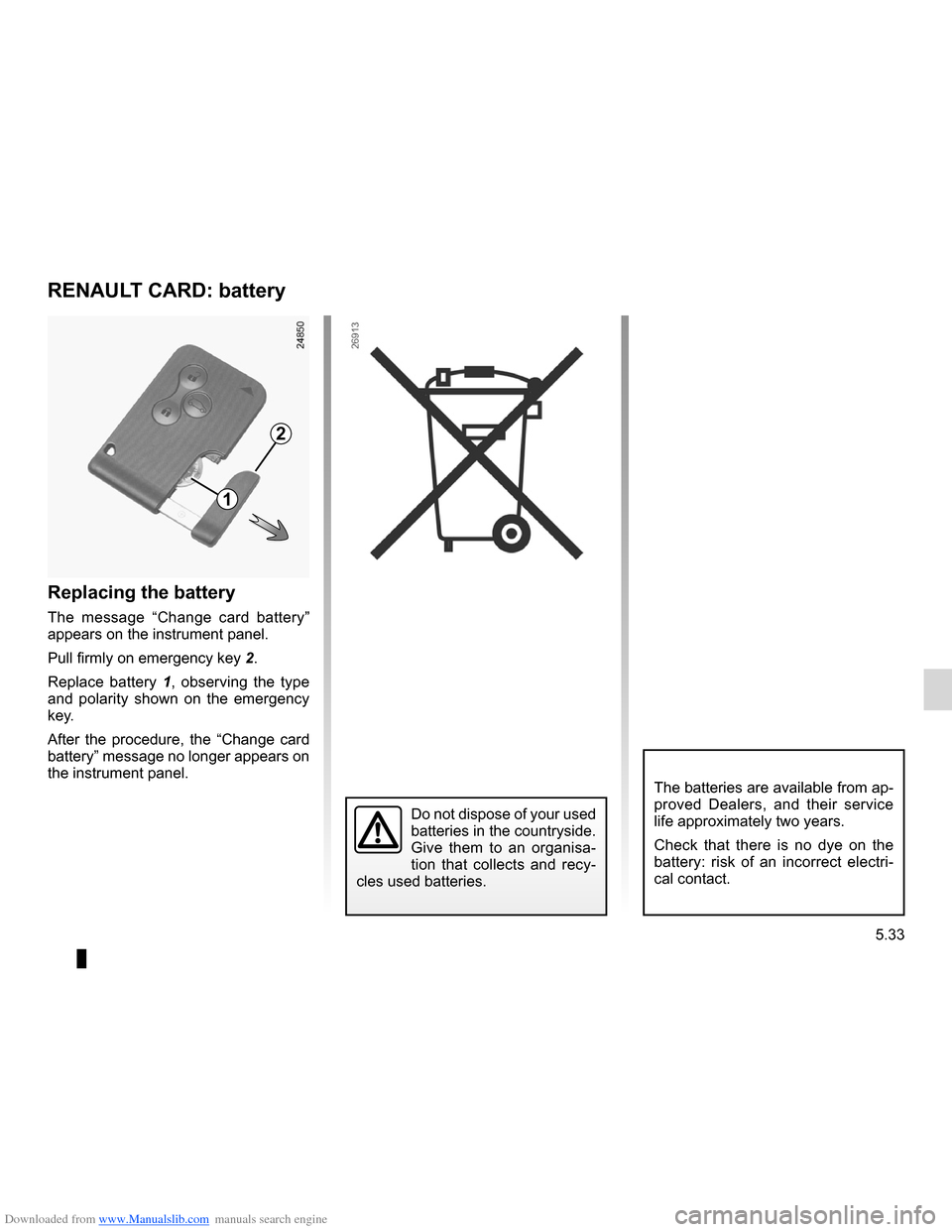
Downloaded from www.Manualslib.com manuals search engine RENAULT cardbattery ............................................. (up to the end of the DU)
RENAULT card battery .........................(up to the end of the DU)
5.33
ENG_UD19814_3
Carte Renault : pile (X85 - B85 - C85 - S85 - K85 - Renault)
ENG_NU_853-7_BCSK85_Renault_5
RENAULT card: battery
Do not dispose of your used
batteries in the countryside.
Give them to an organisa -
tion that collects and recy -
cles used batteries.
Replacing the battery
The message “Change card battery”
appears on the instrument panel.
Pull firmly on emergency key 2.
Replace battery 1, observing the type
and polarity shown on the emergency
key.
After the procedure, the “Change card
battery” message no longer appears on
the instrument panel.
RENAULT CARD: battery
1
2
The batteries are available from ap-
proved Dealers, and their service
life approximately two years.
Check that there is no dye on the
battery: risk of an incorrect electri -
cal contact.